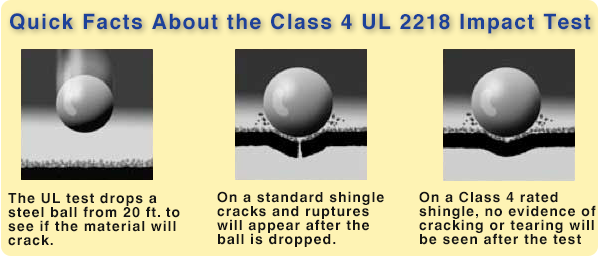Underwriters Laboratories (UL) is a not-for-profit independent testing organization that was founded in 1894. UL provides the knowledge and expertise to help consumers make informed decisions on products that affect their every-day lives.
UL developed a way to test the impact resistance of roofing shingles in order to simulate how the shingles hold up to hail damage. Multi-sized simulated hailstones, ranging from 1.25”-2” in diameter; made of steel, plastic or ice are propelled or dropped onto test roofing materials(shingles) with predetermined impact values. These values are derived from the impact energy of hailstones. This test is called the UL 2218 Impact Rating Test.

In order to meet the acceptance criteria of UL 2218, the roofing material, back surface and underneath layers must show no signs of tearing, fracturing, cracking, splitting, rupture, crazing or other evidence of opening of the roof covering layer. The size of the simulated hail stone used to achieve a class 4 rating is 2” in diameter. The test results determine whether a product rates from Class 1 to Class 4; Class 4 being the most resistant to hail damage impacts.
This article is part of our ‘Residential/ Steep Slope Materials’ Series. Learn more about:
- Asphalt Composite Shingles
- Metal Roofing
- Wood/ Cedar Roofing
- Other
- Roof Component Materials
- Traditional “Organic” Felt vs Synthetic Underlayment: Which is better?
- What Is the Difference Between Open and Closed Valley Installation?
- Continuous Venting Ridge vs Static/Box Vents: Which is better?
- What Are the Benefits to a High Profile Hip and Ridge Shingle?
- What Is a Class 4 Rating? Who Makes That Determination?



